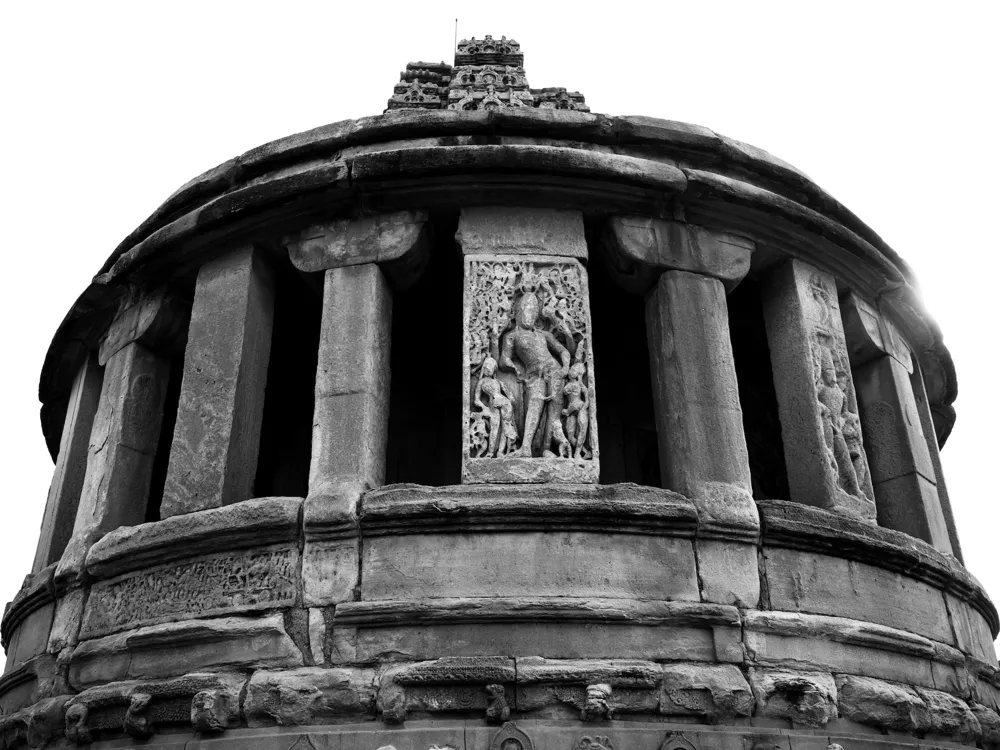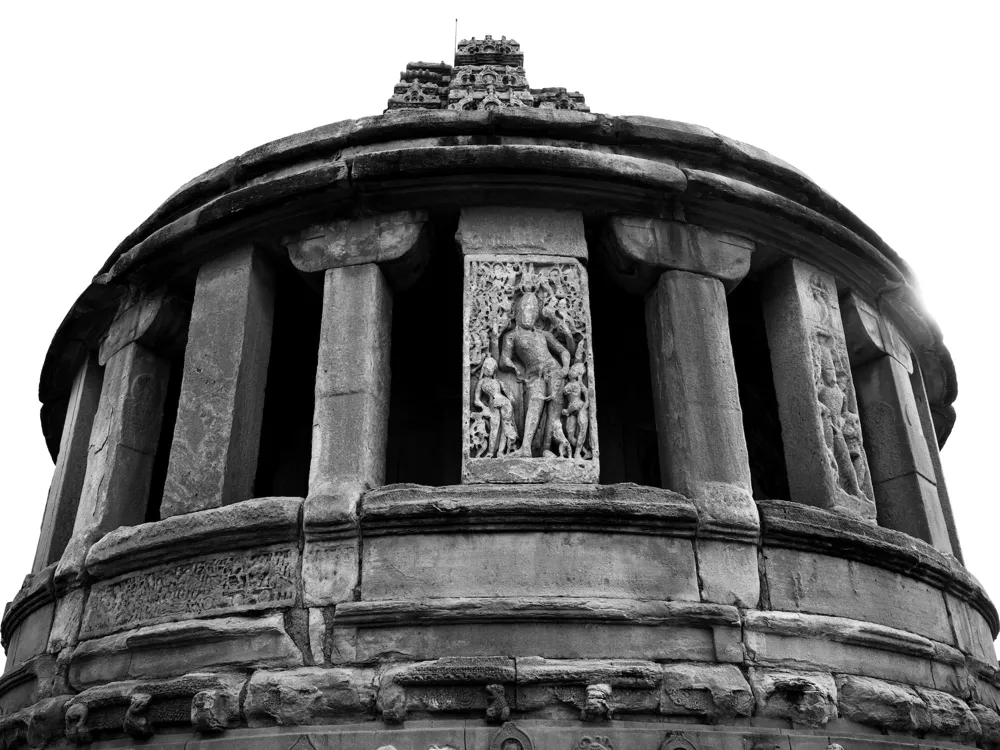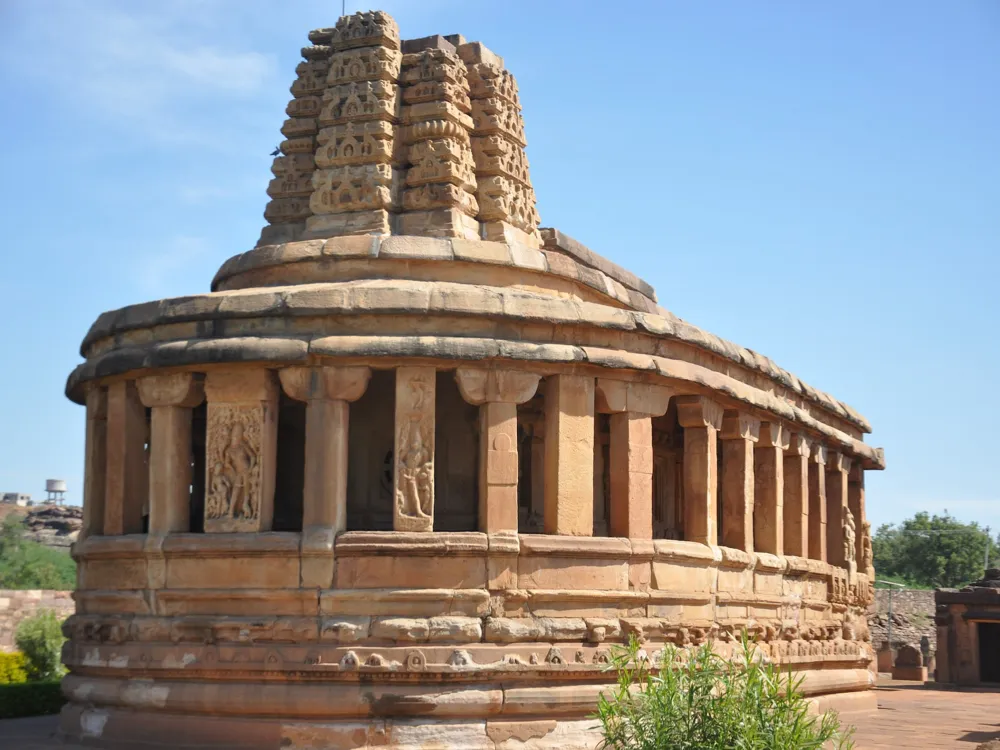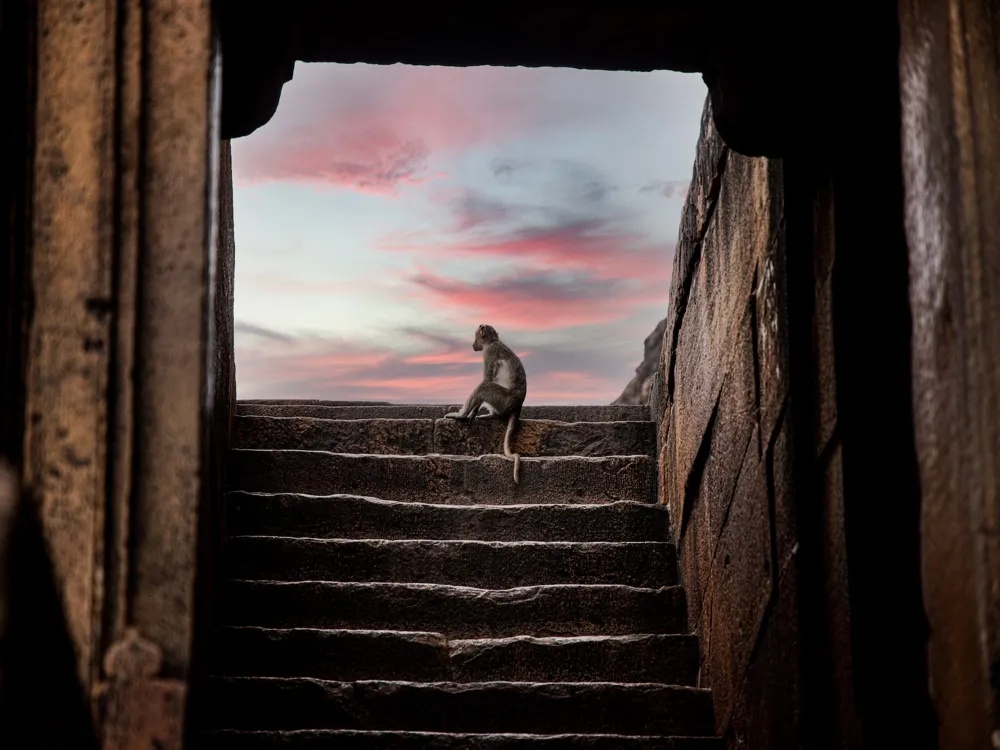The Ambigera Gudi group, nestled in the historic town of Aihole in Karnataka, India, is a remarkable ensemble of ancient temples. These temples, dating back to the 6th and 8th centuries, stand as a testament to the architectural prowess of the Chalukya dynasty. Aihole, often referred to as the 'Cradle of Indian Architecture', boasts over 120 temples, with the Ambigera Gudi group being a significant highlight. This group consists of three main temples, each showcasing unique architectural styles and intricate carvings that illustrate stories from Hindu mythology. The central temple, dedicated to Lord Shiva, is particularly notable for its circular sanctum (garbhagriha) and meticulously carved ceiling panels. The surroundings of these temples are dotted with smaller shrines and relics that speak volumes of the historical and cultural significance of the region. The Ambigera Gudi group not only represents the religious and spiritual beliefs of its era but also offers insights into the socio-cultural context of the time. Its strategic location near the Malaprabha River indicates the importance of water bodies in temple architecture. Furthermore, the temples serve as an excellent example of the evolution of temple architecture in South India, marking the transition from rock-cut caves to free-standing structural temples. Visitors to the Ambigera Gudi group are often struck by the harmonious blend of architectural styles, including the Nagara style of North India and the Dravidian style of the South. This fusion is indicative of the inclusive nature of the Chalukya dynasty's rule, which embraced and encouraged diverse cultural and artistic influences. The intricate carvings, elaborate sculptures, and the overall grandeur of the temples make the Ambigera Gudi group a must-visit for anyone interested in history, architecture, and the enduring legacy of ancient India. The Ambigera Gudi group of temples showcases a distinctive blend of architectural styles, combining elements from different regions and periods. The most striking aspect of these temples is their ability to harmoniously integrate various architectural forms, creating a unique aesthetic that is both majestic and intricate. The main temple, dedicated to Lord Shiva, stands out with its circular garbhagriha, a feature uncommon in South Indian temple architecture. The sanctum's outer walls are adorned with a series of miniature decorative towers (shikharas), each intricately carved with deities and mythological figures. The temple's inner sanctum is equally impressive, with a lingam (symbol of Lord Shiva) at its center, surrounded by an array of sculptures and reliefs depicting scenes from Hindu epics. The ceilings of the Ambigera Gudi temples are noteworthy for their elaborate carvings, featuring a variety of geometric and floral patterns. These ceilings not only enhance the aesthetic appeal of the temples but also demonstrate the advanced engineering and architectural skills of the Chalukya artisans. The use of local sandstone in construction adds to the temples' rustic charm and has ensured their endurance through centuries. The layout of the temple complex follows a well-thought-out plan, with each structure strategically placed to create a sense of balance and symmetry. The presence of various subsidiary shrines and mandapas (pavilions) within the complex suggests that the Ambigera Gudi group was not just a place of worship but also a center for community gatherings and cultural activities. This multifaceted approach to temple architecture is a hallmark of the Chalukyan era and is vividly manifested in the Ambigera Gudi group. The ideal time to visit the Ambigera Gudi group is between October and March when the weather is pleasant, making it comfortable to explore the temple complex. Avoid the summer months as temperatures can be extremely high. Opt for a guided tour to gain a deeper understanding of the historical and architectural significance of the temples. Local guides are available who can provide insightful stories and details about the Ambigera Gudi group. Dress conservatively and remove footwear before entering the temple premises. It's important to respect the cultural and religious sentiments of the place. Photography is usually allowed, but it's advisable to check for any restrictions and always be respectful of worshippers and rituals taking place. The Ambigera Gudi group in Aihole is accessible by various modes of transportation. The nearest airport is in Belgaum, about 150 kilometers away. From there, one can hire a taxi or take a bus to reach Aihole. The closest railway station is in Bagalkot, approximately 34 kilometers from Aihole. Regular bus services connect Aihole to major cities in Karnataka, making it convenient for visitors to reach the temple complex. For those driving, Aihole is well-connected by road to major cities like Bengaluru, Mumbai, and Hyderabad. The journey offers a scenic route through the countryside, providing a glimpse into rural Karnataka. Upon reaching Aihole, local transportation options like auto-rickshaws and taxis are available to take visitors to the Ambigera Gudi group. Read More:Overview of Ambigera Gudi Group of Aihole, Karnataka
Architecture of Ambigera Gudi Group
Tips When Visiting Ambigera Gudi Group
Best Time to Visit
Guided Tours
Dress Code and Etiquette
Photography
How To Reach Ambigera Gudi Group
Ambigera Gudi group
Aihole
Karnataka
NaN onwards
View aihole Packages
Aihole Travel Packages
View All Packages For Aihole
Top Hotel Collections for Aihole

Private Pool

Luxury Hotels

5-Star Hotels

Pet Friendly
Top Hotels Near Aihole
Other Top Ranking Places In Aihole
View All Places To Visit In aihole
Faq on Aihole
What is the Ambigera Gudi group in Aihole?
The Ambigera Gudi group in Aihole refers to a cluster of ancient Hindu temples located in Aihole, Karnataka, India.
How many temples are there in the Ambigera Gudi group?
The Ambigera Gudi group consists of around four temples, each displaying unique architectural features and historical significance.
When were the temples of the Ambigera Gudi group built?
The temples in the Ambigera Gudi group were built during the Chalukya period, which spanned from the 6th to the 12th century CE.
What is the architectural style of the Ambigera Gudi group temples?
The temples in the Ambigera Gudi group exhibit a mix of architectural styles, including Chalukyan, Dravidian, and Nagara styles, showcasing the evolution of temple architecture in the region.
Are the temples of the Ambigera Gudi group still active for worship?
Yes, some of the temples in the Ambigera Gudi group are still active for worship, while others are maintained as historical sites and tourist attractions.
View aihole Packages
Aihole Travel Packages
View All Packages For Aihole
Top Hotel Collections for Aihole

Private Pool

Luxury Hotels

5-Star Hotels

Pet Friendly
Top Hotels Near Aihole
Other Top Ranking Places In Aihole
Faq on Aihole
What is the Ambigera Gudi group in Aihole?
The Ambigera Gudi group in Aihole refers to a cluster of ancient Hindu temples located in Aihole, Karnataka, India.
How many temples are there in the Ambigera Gudi group?
The Ambigera Gudi group consists of around four temples, each displaying unique architectural features and historical significance.
When were the temples of the Ambigera Gudi group built?
The temples in the Ambigera Gudi group were built during the Chalukya period, which spanned from the 6th to the 12th century CE.
What is the architectural style of the Ambigera Gudi group temples?
The temples in the Ambigera Gudi group exhibit a mix of architectural styles, including Chalukyan, Dravidian, and Nagara styles, showcasing the evolution of temple architecture in the region.
Are the temples of the Ambigera Gudi group still active for worship?
Yes, some of the temples in the Ambigera Gudi group are still active for worship, while others are maintained as historical sites and tourist attractions.





















